
Aesop's Fables (c. 500 BC)
 |
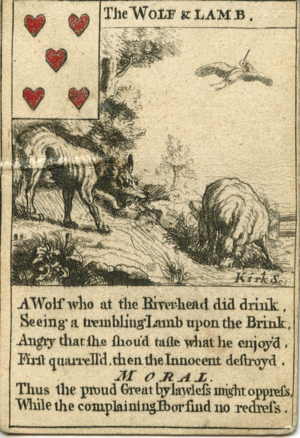 |
| Aesop c. 620–564 BCE | Playing Card c. 1756 |
Introduction
Aesop's Fables are one of the "great books" of western civlisation which for over 2,0000 years has provided a kind of blank slate on which other authors could write their comments and moral interpretations of the events described in the stories. The basic stories appear quite innocuous on the surface but many of them contain a thinly disguised critique of political and social injustices which editors over the centuries have seized upon for their editorial "Comments" which are attached to each story. Thus we have conservative monarchist readings of Aesop, a French Humanist reading, a Whig reading, and a Commonwealthman reading, along with several homiletic Christian readings. Several also have wonderful etchings which accompany the stories. One of the themes in the stories of interest to libertarians is the problem of predators (foxes, wolves, lions) and how ordinary people can either outwit them or avoid them (i.e. being eaten, or being "fleeced" by them).
Texts in the Collection
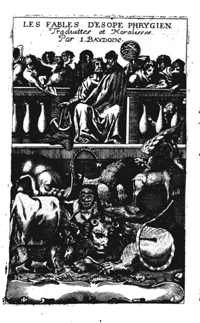 |
Jean Baudoin, Les Fables d’Esope Phrygien. Traduction Nouvelle. Illustrée de Discours Moraux, Philosophiques et Politiques, par J. Baudoin. Avec les figures en taille douce (Roüen, Jean et David Berthelin, ruë aux Juifs, et dans la Court du Palais, M.DC.LX. (1660)). In HTML. I have not been able to find the facs. PDF of this edition but have put online the 1665 edition. [See below] |
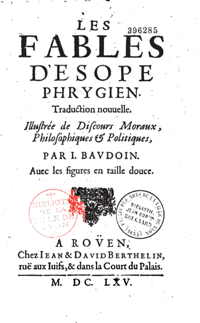 |
Jean Baudoin, Les Fables d’Esope Phrygien. Traduction Nouvelle. Illustrée de Discours Moraux, Philosophiques et Politiques, par J. Baudoin. Avec les figures en taille douce (Roüen, Jean et David Berthelin, ruë aux Juifs, et dans la Court du Palais, M.DC.LX. (1665)). There are 118 illustrations which can be viewed here. |
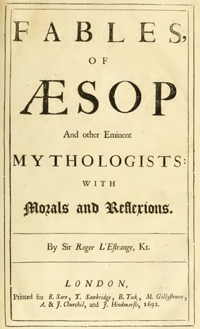 |
Roger L'Estrange, Fables of Æsop and other eminent Mythologists with Morals and Reflexions (London: Printed for R. Sare, T. Sawbridge, B. Took, M. Gillyflower, A. & J. Churchil, and J. Hindmarsh, 1692).
Written by a defender of the monarchy with a frontispiece which emphasises Aesapos physical deformaties (linked supposedly to his "moral deformities" unless "corrected" by suitable "Moral" conclusions supplied by the editor/translator). |
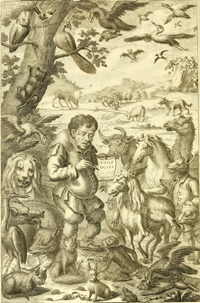 |
t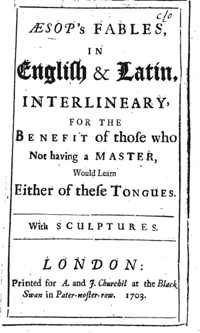 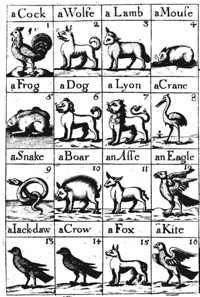 |
Æsop’s Fables in English and Latin, Interlineary, for the Benefit of those who not having a Master, would Learn either of these Tongues. With Sculptures. [Edited by John Locke.] (London: A. & J. Churchil, 1703). Unfortunately, I do not have an HTML version but only a facs. PDF. Locke missed an opportunity here with his commenatray not to have a more "libertarian" edition of Aesop. He had recommended Aesap's fables in his treatise Some Thoughts Concerning Education (1693) as a way for children to learn both Latin and English composition. There was a collection of pictures of animals to help the early reader to spell
So from Locke, we learn that both "Lyon" and "Lamb" begin with the letter L, but not that lions prey and kill lambs and that therefore "lambs" need to be very careful of predators like "lions" whether in animal or human form. |
t |
Bernard Mandeville, Aesop Dress’d; Or, A Collection of Fables Writ in Familiar Verse (London, Sold at Lock’s-Head adjoyning to Ludgate. 1704). |
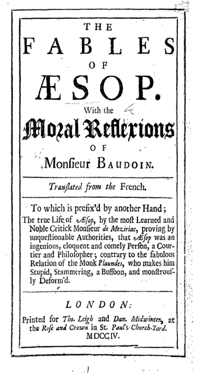 |
The English rationalist, Commonwealthman, and radical Whig John Toland published a translation of the Baudoin version in 1704: The Fables of Aesop. With the Moral Reflections of Monsieur Baudoin. Translated from the French. To which is prefix’d by another Hand; The True Life of Aesop, by the most Learned and Noble Critick Monsieur de Meziriac, proving by unquestionable Authorities, that Aesop was an ingenious, eloquent and comely Person, a Courtier and Philosopher; contrary to the fabulous Relation of the Monk Plaundes, who makes him Stupid, Stammering, a Buffoon, and monstrously Deform’d. (London: Tho. Leigh and Dan. Midwinter, 1704). |
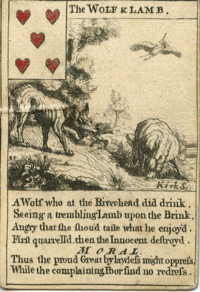 |
Aesop's Fables by J Kirk, St Paul's Churchyard, London 1756-65. From: Worshipful Company of Playing Cards Collection Acquisition No. 221 - Playing Card Makers Collection. HTML - with small and links to larger images. |
 |
Edward Baldwin [William Godwin], Fables Ancient and Modern. Adapted for the Use of Children from Three to Eight Years of Age. By Edward Baldwin, Esq. Published by Thos. Hodgkins. Hanway Street, Oct.r 6. th 1805. London: Printed for Thomas Hodgkins, At the JUVENILE LIBRARY, Hanway Street (Opposite Soho Square), Oxford Street; and to be had of all Booksellers. [Second Edition.] Vol. I. Adorned with Thirty-six Copper-Plates. Vol. II Adorned with Thirty-seven Copper-Plates. [by William Mulready]. Printed by B. McMillan, Bow Street, Covent Garden Editor's Note: The HTML and images come from “Romantic Circles” at the University of Colorado, Boulder, eds. Paul Youngquist and Orrin N.C. Wang. I have not been able to find a facs. PDF version of this edition but I have checked it against the one volume 4th edition of 1808. The radical individualist and anatrchist William Godwin also missed an opportunity (as Locke had done) to do a more "libertarian" edition of the Fables. Perhaps he didn't want to offend the customers of his ecducation publishing company "The Juvenile Library" of which the Fables was a part. Thus, there were too many "happy endings" instead of warnings to the weak and powerless to be careful of con-artists and predators who will steal from them or even kill them. |
| tp | blurb [HTML and facs. PDF] |